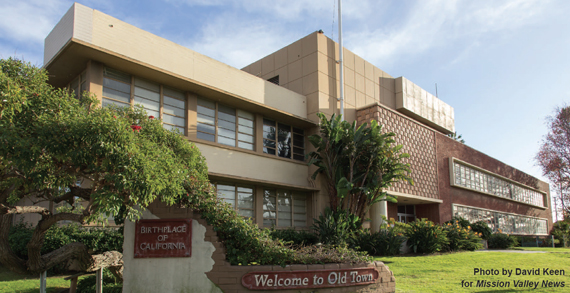|
Old Town on new path with acquisition of old Caltrans building
California state legislature clears a path
By Jeremy Ogul
12/13/13 - Mission Valley News - Original article
 The old Caltrans building will soon be demolished and a new building will inherit the property. The old Caltrans building will soon be demolished and a new building will inherit the property.
Some of the most important parts of Old Town's history have been buried under a state office building since the mid-20th century, but a recent move by the California state legislature has finally cleared a path for officials to demolish the building and enact a new vision for the property.
State lawmakers agreed in November to transfer the old Caltrans office building, at the corner of Taylor and Juan streets, to the state parks system. The transaction adds approximately 2.48 acres to the existing 12.96 acres of the Old Town State Historic Park.
"It's certainly the most significant addition since Old Town was created," said Clay Phillips, superintendent of the San Diego regional district of the California state parks system.
Parks officials plan to use the property to tell the story of Old Town's relationship to the San Diego River, which lowed roughly where Taylor Street is today before the river was redirected into Mission Bay, Phillips said.
It will also be used help park visitors understand the history of Native Americans in the area, whose presence at the site stretches back to approximately 500 C.E., when ancestors of the Kumeyaay tribe established a village there on the banks of the river.
The transfer was originally proposed more than seven years ago, when Caltrans moved its offices from the building to a new, larger complex on the north side of Taylor Street, adjacent to Interstate 8. The transfer was delayed, however, by bureaucratic red tape that limits the ability of state agencies to sell their property directly to other state agencies.
"This action preserves a site rich with our heritage and removes an eyesore from the historic center of our city," said California State Assembly Majority Leader Toni Atkins, whose legislation facilitated the transfer. Since 2009, $762,000 in parks funds have been set aside for planning and design for the site, and total of $7.1 million in bond funds have also been designated for the project, according to Atkins's office.
The transition will take many years, Phillips said.
Before demolition can begin, the state must put together an environmental impact report that accounts for the existing building's historic value as well as the environmental hazards associated with demolition. The demolition will require extra care on the part of work crews because of hazardous substances such as asbestos that pervade the building. There is also a gasoline plume in the soil beneath the building.
Park officials don't expect to be gin demolition on the building for another year and a half, Phillips said.
Upon demolition, officials will begin excavating the property in search of historic artifacts.
Historians expect to find evidence and remnants of Fitch's store, the first retail store in California, built in the mid-1800s by Henry Fitch, a titan of Old Town history. They also expect to find evidence of Lyon's Bowling Saloon, built in 1853 by a man who would later become sheriff, a several adobes dating to the 1830s.
"It really is our Plymouth Rock, our Plymouth village, our Jamestown," said Bruce Coons, executive director of the Old Town-based Save Our Heritage Organisation.
There are few places more significant to the modern history of the western U.S., Coons said.
The existing building has some historic value itself as a representative of the mid-century modernist architectural style. It is eligible for the National Register of Historic Places and other state and local historical designations and protections, which makes demolition more precarious.
"Our modernist group looked at it and felt that the building was important, but that the underlying history was even more important. It's a hard judgment sometimes," Coons said.
In the early 20th century, before the office building was established, the property was home to a Mission revival building that housed an olive processing facility. Workers from that business were the original clientele of what became the La Piñata Mexican restaurant on Juan Street today.
Park officials will consult with stakeholders to develop a plan for the future use of the site. Those stakeholders include American Indian tribes with ties to the land, local historians, Old Town business owners, nearby residents and organizations with an interest in the San Diego River.
The site will ultimately serve as Old Town's new front door, Coons said.
Coons said he hopes the future redevelopment of the site will capture the rural feel of the village on the river banks, complete with the native plants and grasses that you would have seen in the 1800s.
"It'll transform the whole area," Coons said. "I think it will feel completely different."
|
ABOUT SOHO
IN THE NEWS - PREVIOUS YEARS
2024 | 2023 | 2022 | 2021 | 2020 | 2019
2018 | 2017 | 2016 | 2015 | 2014 | 2013
2012 | 2011 | 2010 | 2009 | 2008 | 2007
2006 | 2005 | 2000-2004 | 1973-1997
|

 The old Caltrans building will soon be demolished and a new building will inherit the property.
The old Caltrans building will soon be demolished and a new building will inherit the property.

